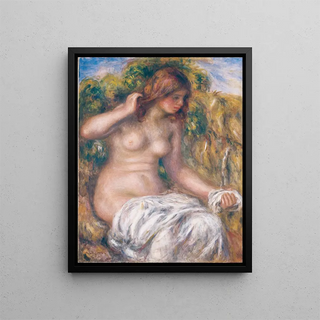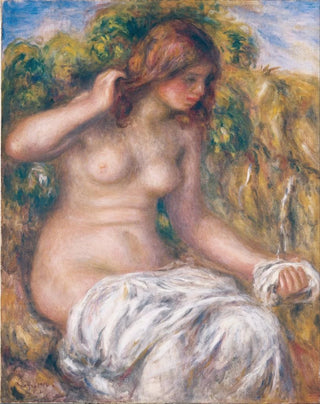Art print | Woman in Spring - Pierre-Auguste Renoir


View from behind

Frame (optional)
Pierre-Auguste Renoir’s “Woman in Spring” is an iconic masterpiece of Impressionism, a movement that revolutionized artistic conventions of its time. Painted in 1876, this artwork perfectly illustrates Renoir’s ability to capture light and life in a fleeting moment. The composition, both delicate and vibrant, evokes a sense of joy and renewal, symbolizing spring in all its splendor. The female figure, at the center of the canvas, appears to blossom amidst a lush landscape, inviting viewers to share a moment of grace and beauty. This feminine representation, both intimate and universal, reflects Renoir’s artistic sensitivity, transcending a simple portrait to offer a true ode to nature and femininity.
Style and uniqueness of the work
Renoir’s style in “Woman in Spring” is characterized by fluid brushstrokes and a palette of luminous colors. Pastel shades, combined with touches of brighter hues, create a radiant and lively atmosphere, typical of his oeuvre. Light plays a central role in this composition, illuminating the woman’s face and the surrounding flowers, while delicate shadows add depth to the scene. The woman’s posture, both natural and elegant, conveys an impression of serenity and happiness, capturing the very essence of spring. Renoir manages to make every detail come alive, from the petals of the flowers to the reflections in his model’s hair. This meticulous attention to detail, combined with an almost Impressionist approach to light and shadow, gives the artwork a sensory dimension that invites contemplation.
The artist and his influence
Pierre-Auguste Renoir, an emblematic figure of Impressionism, profoundly influenced art history with his innovative approach and unique sensitivity. Born in 1841, he evolved over the years, integrating elements from different artistic schools while remaining faithful to his personal vision. His work is a testament to the beauty of the world around him, and “Woman in Spring”

Matte finish

View from behind

Frame (optional)
Pierre-Auguste Renoir’s “Woman in Spring” is an iconic masterpiece of Impressionism, a movement that revolutionized artistic conventions of its time. Painted in 1876, this artwork perfectly illustrates Renoir’s ability to capture light and life in a fleeting moment. The composition, both delicate and vibrant, evokes a sense of joy and renewal, symbolizing spring in all its splendor. The female figure, at the center of the canvas, appears to blossom amidst a lush landscape, inviting viewers to share a moment of grace and beauty. This feminine representation, both intimate and universal, reflects Renoir’s artistic sensitivity, transcending a simple portrait to offer a true ode to nature and femininity.
Style and uniqueness of the work
Renoir’s style in “Woman in Spring” is characterized by fluid brushstrokes and a palette of luminous colors. Pastel shades, combined with touches of brighter hues, create a radiant and lively atmosphere, typical of his oeuvre. Light plays a central role in this composition, illuminating the woman’s face and the surrounding flowers, while delicate shadows add depth to the scene. The woman’s posture, both natural and elegant, conveys an impression of serenity and happiness, capturing the very essence of spring. Renoir manages to make every detail come alive, from the petals of the flowers to the reflections in his model’s hair. This meticulous attention to detail, combined with an almost Impressionist approach to light and shadow, gives the artwork a sensory dimension that invites contemplation.
The artist and his influence
Pierre-Auguste Renoir, an emblematic figure of Impressionism, profoundly influenced art history with his innovative approach and unique sensitivity. Born in 1841, he evolved over the years, integrating elements from different artistic schools while remaining faithful to his personal vision. His work is a testament to the beauty of the world around him, and “Woman in Spring”






